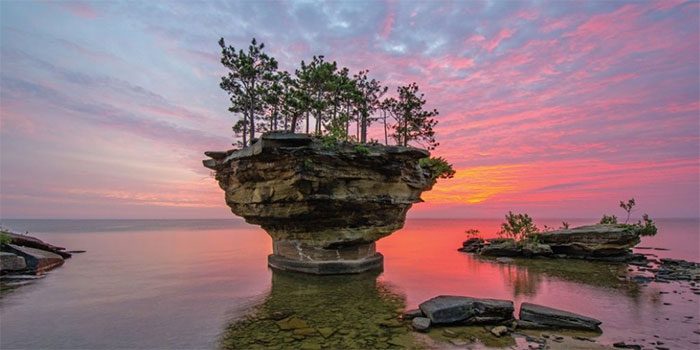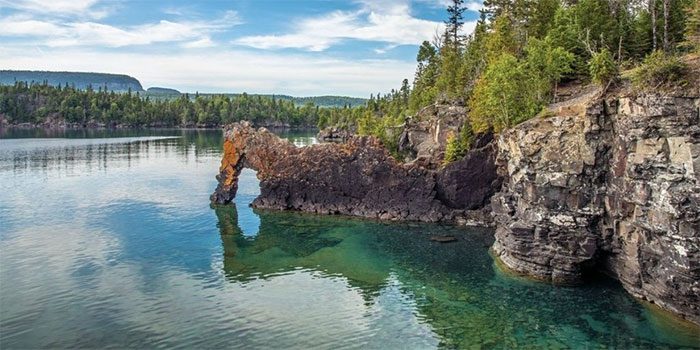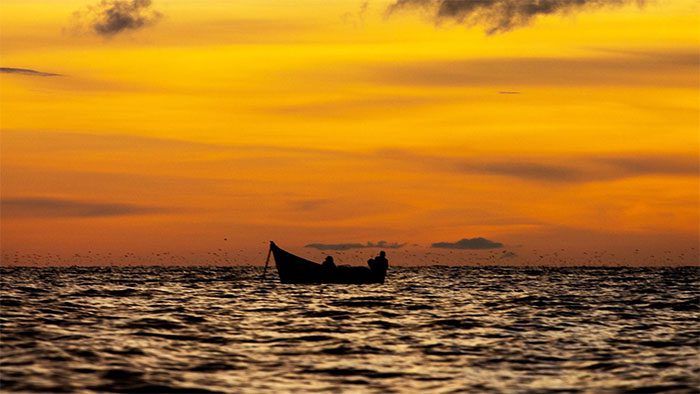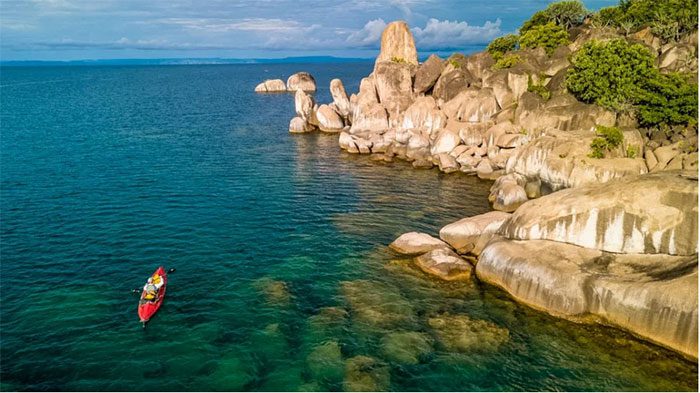According to estimates, there are approximately 2 million lakes on Earth. However, where are the largest lakes in the world located? Do you know? Let’s follow the article below to find out which lakes these are!
1. Lake Michigan-Huron – 117,702 km²
Geologically, Lake Michigan-Huron is considered the largest lake among the Great Lakes in North America. This lake actually consists of two interconnected lakes, Lake Michigan and Lake Huron, joined by the Mackinac Strait. With an area of up to 117,600 km², Lake Michigan-Huron is recognized as the second largest lake in the world.

Lake Michigan-Huron is recognized as the second largest lake in the world. (Photo: Geojango)
Initially, this body of water was divided into two separate lakes for a long time. However, the surface water levels of the two lakes are equal, and they rise and fall simultaneously, with the water flow between them sometimes reversing. Therefore, the National Oceanic and Atmospheric Administration of the United States and the U.S. Army Corps of Engineers have confirmed that, “Lake Michigan and Huron are considered one single lake hydraulically because they are connected by the Mackinac Strait.”
2. Lake Superior – 82,103 km²
Lake Superior, part of the Great Lakes in North America, is the largest freshwater lake in the world by surface area at 82,100 km², roughly the size of Austria. The lake also holds 10% of the world’s unfreezing freshwater supply. Lake Superior borders Ontario (Canada) to the north, Minnesota (USA) to the west, and the states of Wisconsin and Michigan (USA) to the south.

Lake Superior, part of the Great Lakes of the USA, is the largest freshwater lake in the world by surface area. (Photo: Geojango)
Fed by the St. Marys River and the Soo Locks, water from Lake Superior flows into Lake Huron. Like other large lakes, Lake Superior was formed by past glacial movements. According to Lake Superior Magazine, it would take 191 years for the lake to completely drain. The lake is home to many fish species such as salmon, sturgeon, bass, and perch. It is also considered an interesting camping and recreational spot for people from both the USA and Canada.
3. Lake Victoria – 69,000 km²
Lake Victoria is the largest freshwater lake in Africa, located at the borders of Uganda, Kenya, and Tanzania. With an area of 69,000 km² and a circumference of 3,440 km, Lake Victoria mainly receives water from direct rainfall and thousands of small rivers and streams.

Lake Victoria has an area of 69,000 km² and a circumference of 3,440 km. (Photo: Geojango)
The lake was formed from a large crack near the equator that lies between the eastern and western sides of the Great Rift Valley. Lake Victoria has undergone changes from its current shallow state from a series of smaller lakes. Core samples taken from the bottom indicate that Lake Victoria has completely dried up at least three times since its formation. Geologically, Lake Victoria is relatively young, about 400,000 years old, and was formed when rivers flowing westward were blocked by uplifted sections of the Earth’s crust.
Lake Victoria is located in East Africa and has a maximum depth of 84 m and an average depth of 40 m. The ecosystem of Lake Victoria is renowned for its biodiversity, hosting up to 500 fish species. However, today, Lake Victoria faces many threats from pollution due to wastewater, industrial waste, fertilizers, and chemicals.
4. Lake Tanganyika – 32,900 km²
According to Mother Nature Network, Lake Tanganyika is the longest lake in the world, located within the territories of four countries: Burundi, the Democratic Republic of the Congo, Tanzania, and Zambia. The lake stretches 673 km north to south and covers approximately 32,900 km². It has a shoreline of 1,828 km and an average depth of 570 m, with a maximum depth of 1,470 m in the northern basin.

Lake Tanganyika spans the territories of four countries: Burundi, the Democratic Republic of the Congo, Tanzania, and Zambia. (Photo: Geojango)
The lake was formed around 12 million years ago along the Great Rift Valley due to the rifting of two continental tectonic plates. According to Livescience, Lake Tanganyika is one of the most biodiverse lakes in the world, hosting over 2,000 species, including up to 600 endemic species. Therefore, Lake Tanganyika is an important source for studying species formation during the process of evolution.
5. Lake Baikal – 31,722 km²
Located in eastern Siberia, Russia, Lake Baikal is vast and crescent-shaped. Scientists believe it is so large that it can hold 22% of the planet’s freshwater supply. Lake Baikal was formed when a massive rift opened in the Eurasian continent. The surface area of Lake Baikal reaches nearly 32,000 km², comparable to several countries such as Belgium, the Netherlands, or Denmark. The average depth of the lake is 744 m.

Scientists believe Lake Baikal is large enough to hold 22% of the planet’s freshwater supply. (Photo: Geojango)
Lake Baikal is one of the oldest lakes, estimated to be around 25-30 million years old. It is home to more plant and animal species than any other lake in the world, hosting over 3,600 species, many of which cannot be found anywhere else.


















































